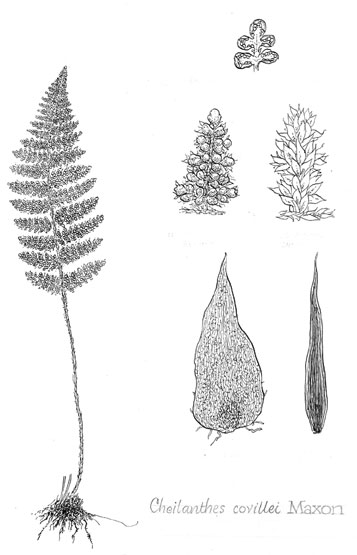|
Hardy Fern Home C. covillei resources
All Ferns � Pteridaceae �� Cheilanthes
�Other Genera
|
| Cheilanthes covillei | ||
Coville's lip fern | ||
|
Etymology
Frederick Coville, a botanist with the US National Herbarium and the US Department of Agriculture.
Description
Rhizome: short-creeping, scales linear, brown with dark central stripe.
Frond: 30 cm high by 5 cm wide, evergreen, monomorphic, blade/stipe ratio: 1:1 to 2:1. Stipe: rounded above, brown to purplish, continuing into rachis and pinna base, lanceolate scales, vascular bundles: 1. Blade: 3-pinnate, said also to be more divided, lanceolate, , noncircinate vernation, leathery or rarely somewhat herbaceous, glabrous above and below, but see costae. Pinnae: 10 to 14 pair, opposite or subopposite; costae scales below ovate-lanceolate, deeply cordate at base, with overlapping basal lobes, conspicuous, the largest 0.4--1.5 mm wide, usually concealing ultimate segments; segments ultimate segments round to oblong, beadlike, the largest 1--3 mm; margins entire; veins free, obscure. Sori: linear � continuous around segment margins, submarginal, indusium: false, sporangia: brown to black or gray, maturity: late spring to fall. Culture
Habitat: rocky slopes, cliffs, and ledges, usually on igneous substrates.
Distribution: North America: Baja California to the northern Sierras to Utah.
Hardy to -15�C, USDA Zone 7.
Distinctive Characteristics
The bead-like ultimate segments are diagnostic among the Cheilanthes
on this site. However, examination of costal scales is necessary to
differentiate this from some other southwestern North American members
of the genus.
Synonyms
Myriopteris covillei (Maxon) A. L�ve & D. L�ve |
|
|

Cheilanthes covillei. From top, left to right: fertile segment, scales removed; frond; pinnule upper surface; lower surface; laminar scale, rhizome scale. �Illustration by Edgar Paulton, from How to Know the Ferns and Fern Allies, John T. Mickel, � 1979 Wm. C. Brown Co. |
